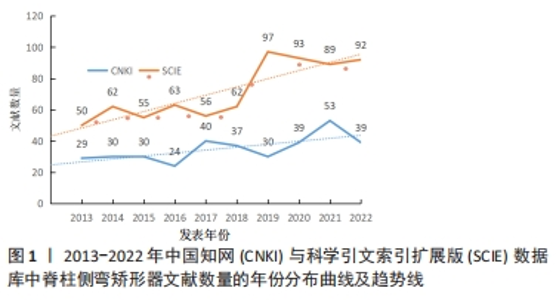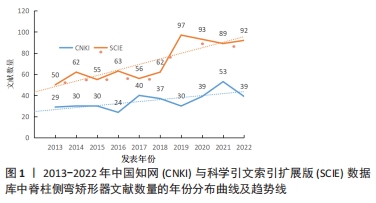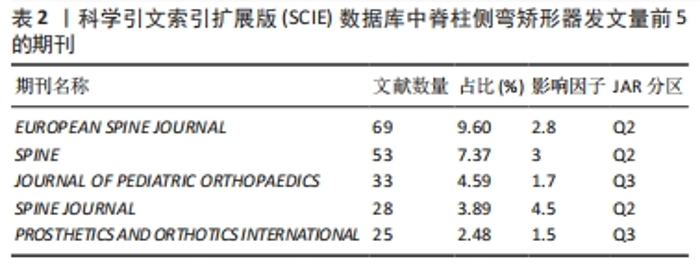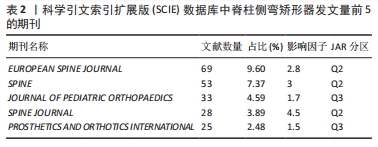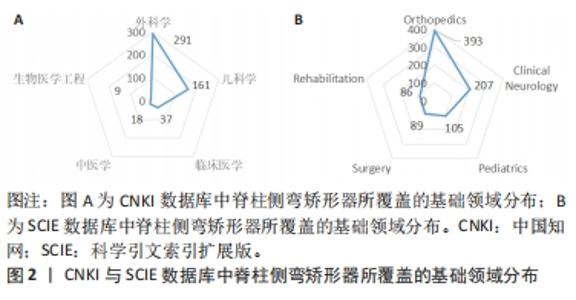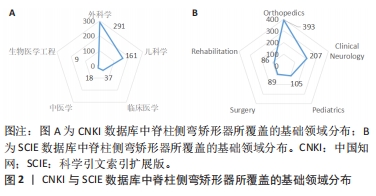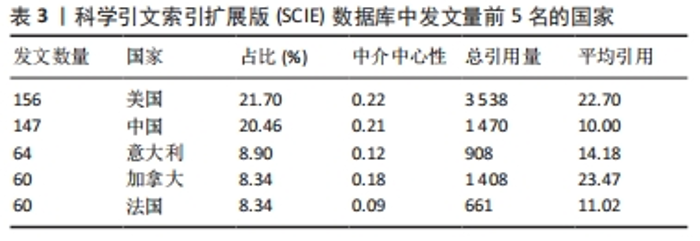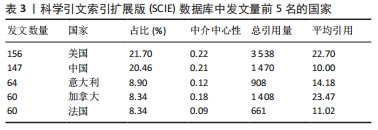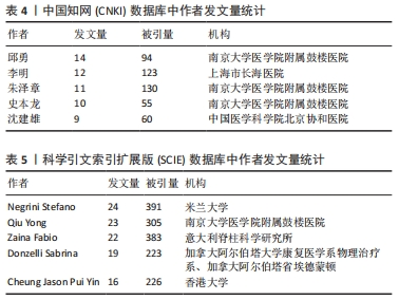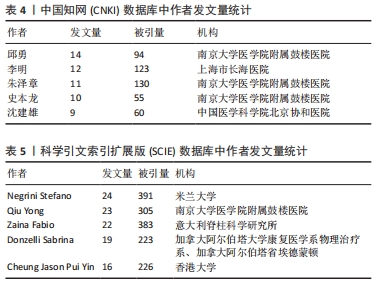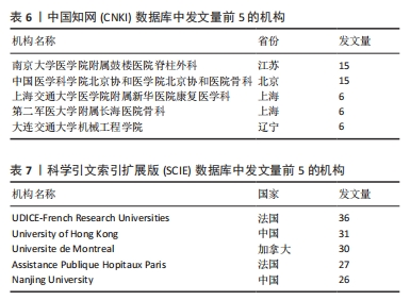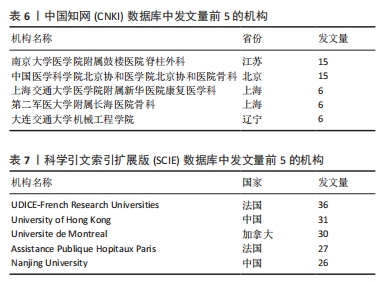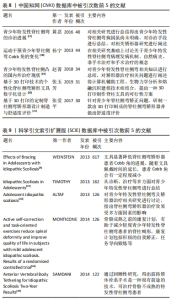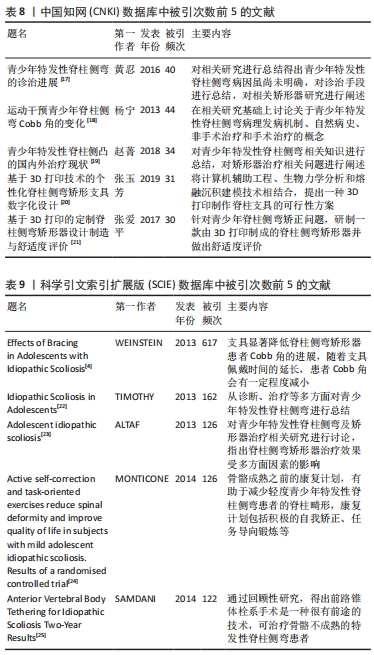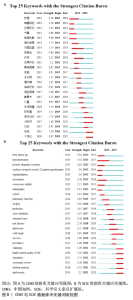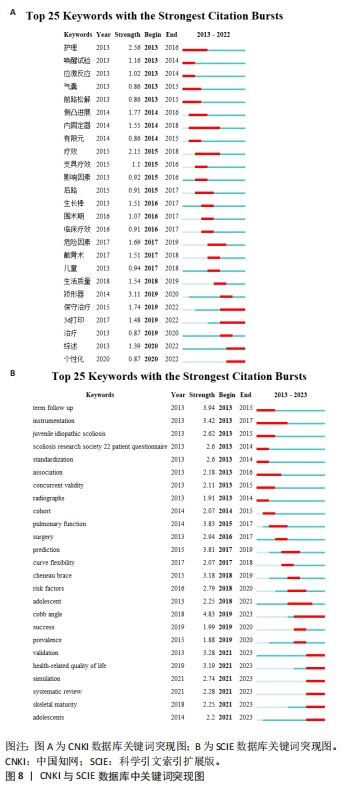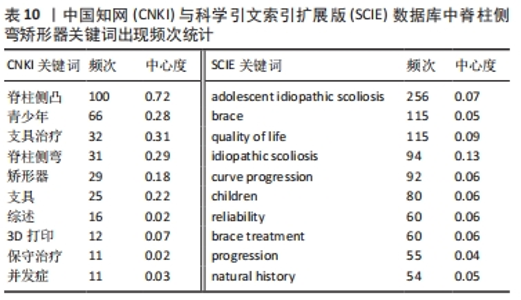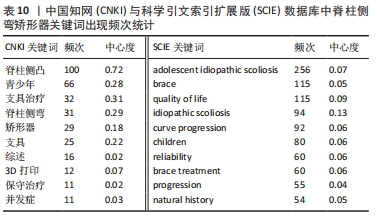Chinese Journal of Tissue Engineering Research ›› 2024, Vol. 28 ›› Issue (33): 5396-5402.doi: 10.12307/2024.642
Previous Articles Next Articles
Bibliometric and visual analysis of domestic and foreign scoliosis orthoses
Yuan Yanli1, 2, Pan Yuejun1, Guan Tianmin1, 2, Cheng Kai1, Wang Xiangheng1
- 1School of Mechanical Engineering, Dalian Jiaotong University, Dalian 116028, Liaoning Province, China; 2Institute of Ergonomics and Rehabilitation Equipment, Dalian Jiaotong University, Dalian 116021, Liaoning Province, China
-
Received:2023-08-24Accepted:2023-09-25Online:2024-11-28Published:2024-01-31 -
Contact:Guan Tianmin, MD, Professor, School of Mechanical Engineering, Dalian Jiaotong University, Dalian 116028, Liaoning Province, China; Institute of Ergonomics and Rehabilitation Equipment, Dalian Jiaotong University, Dalian 116021, Liaoning Province, China -
About author:Yuan Yanli, MD, Associate professor, Master’s supervisor, School of Mechanical Engineering, Dalian Jiaotong University, Dalian 116028, Liaoning Province, China; Institute of Ergonomics and Rehabilitation Equipment, Dalian Jiaotong University, Dalian 116021, Liaoning Province, China
CLC Number:
Cite this article
Yuan Yanli, Pan Yuejun, Guan Tianmin, Cheng Kai, Wang Xiangheng. Bibliometric and visual analysis of domestic and foreign scoliosis orthoses[J]. Chinese Journal of Tissue Engineering Research, 2024, 28(33): 5396-5402.
share this article
Add to citation manager EndNote|Reference Manager|ProCite|BibTeX|RefWorks
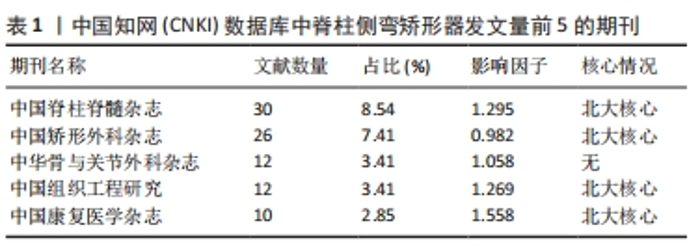
2.1.2 期刊分布 核心期刊群所发表的文献能代表该领域热点问题,可以为领域学者的研究提供重要参考期刊源。将CNKI与SCIE数据库中脊柱侧弯矫形器发文量前5的期刊进行排列,见表1,2。根据布拉德福定律[11],按载文量的多少可以将期刊划分为3个区域,领域内最核心区期刊的文献数量约为总数的1/3,即351/3=117,则核心期刊为《中国脊柱脊髓杂志》《中国矫形外科杂志》等。在国内《中国脊柱脊髓杂志》发文量最多为30篇,其次为《中国矫形外科杂志》发文量为26篇,其他期刊也有一定发文量。SCIE中核心区期刊的文献数量为719/3=239.67,向上取整为240篇。国外脊柱侧弯矫形器领域的核心发文期刊群为《EUROPEAN SPINE JOURNAL》《SPINE》《JOURNAL OF PEDIATRIC ORTHOPAEDICS》等。国外发文量最多的是《EUROPEAN SPINE JOURNAL》为69篇,其次是《SPINE》为53篇,其他期刊也有较多发文量。综合来看,国内外脊柱侧弯矫形器核心期刊有一定的影响因子,可以推测出该领域已经取得重要的研究成果。"
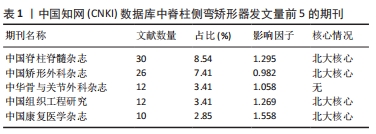
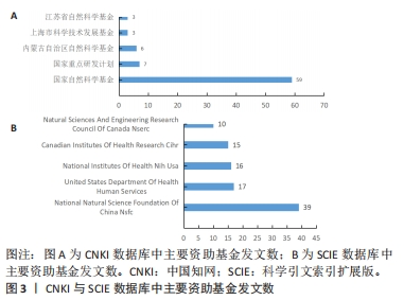
可以看出,国内外基础领域分布情况不同。国内基础领域分布的前2位为外科学与儿科学,国外前2位为矫形学与临床神经学。在国内前2位的外科学与儿科学在国外处于第3位与第4位,中外文献的脊柱侧弯矫形器研究领域有较大差异。值得注意的是,国内文献在中医学领域也有一定的期刊,说明国内存在一定中西医结合治疗脊柱侧弯的研究。 2.1.4 基金来源 在基础领域分布基础上进一步分析研究文献的基金来源,统计基金论文数量和基金资助来源有助于了解研究领域受重视的程度[12]。国内外文献资助基金前5名如图3所示。从图中可以看到受国家自然科学基金资助的文献最多,共计有59篇,其他相关基金也有所资助,国内基金来源相对较为集中,说明国内脊柱侧弯矫形器的研究有较为稳定的基金支持。国外文献中有257篇论文受National Natural Science Foundation Of China(中国国家自然科学基金)资助。从国内外基金资助来看,基金目前主要为国家级或者省部级基金,说明脊柱侧弯矫形器研究受到国家和社会的一定重视。国家自然科学基金都处于第一位置,说明国家自然科学基金对于脊柱侧弯矫形器的研究支持力度较大。"
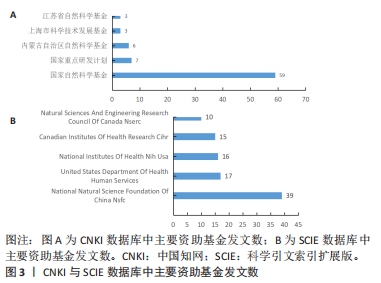
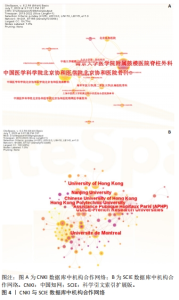
机构合作图谱分析可以反映各机构之间的合作关系,为相关学者进行学术交流提供参考。CNKI与SCIE数据库中机构合作网络如图4所示。在CNKI数据库中,由241个节点与155条边构成,网络密度为0.005 4,整体来看各个研究机构之间的联系较为松散,还有较多的机构在独立的进行研究。但南京大学医学院附属鼓楼医院脊柱外科与相关机构形成了最大的合作网络。SCIE数据库中,由265个节点与727条边构成,网络密度为0.020 8。研究机构之间的合作相比国内研究机构之间的合作频繁,说明各个机构在国际上有一定交流。可以推断出在国际上脊柱侧弯矫形器研究取得一定的共识。通过对比可以看出国内研究机构联系非常少,某些机构甚至进行独立研究,国外机构之间的联系比国内机构之间的联系多。整体来看,中外机构合作相对较少,该领域内的相关学者仍需增强交流与互动,共同地推动脊柱侧弯矫形器研究的创新发展。"
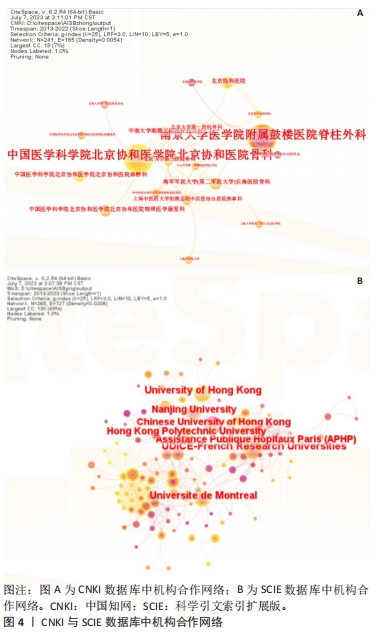
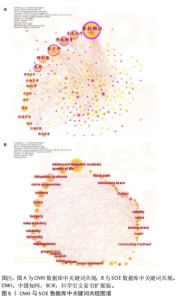
在国内,主要针对脊柱侧弯矫形器的制作进行研究,通过3D打印解决矫形器的制作。国外研究的主要内容为通过相关实验验证脊柱侧弯矫形器的效果等。国内学者注重新制作方式的研究,国外学者注重与实际病例相结合,探索脊柱侧弯矫形器的综合效果。 2.2 脊柱侧弯矫形器热点及趋势 2.2.1 关键词词频及共现分析 关键词是文章的核心主题,是对文章内容的高度概括[26]。近10年关键词频率前5名如表10所示。关键词中脊柱侧凸、青少年、支具治疗等出现频次较高。从中心性来看脊柱侧凸、青少年、支具治疗等节点发挥重要的枢纽作用。去除与研究主题直接相关的关键词,综合关键词使用频次与中心度,“青少年、3D打印”可以作为关键词共现网络的关键节点,说明国内比较注重青少年脊柱侧弯的矫形器治疗,矫形器制作方式为3D打印。SCIE数据库中关键词Adolescent idiopathic scoliosis(青少年特发性脊柱侧弯)、brace(支具)、quality of life(生活质量)、idiopathic scoliosis(特发性脊柱侧弯)等节点在文献中出现的频次较多。其中,特发性脊柱侧弯中心度较高,在图谱中起到重要枢纽作用。综合关键词频次与中心度,“青少年特发性脊柱侧弯、特发性脊柱侧弯、生活质量”可视为关键节点,反映了国外脊柱侧弯矫形器的核心研究主题。关键词共现图谱如图5所示,脊柱侧凸、支具治疗、脊柱侧弯、青少年特发性脊柱侧凸等相关关键词节点较大,体现出这些关键词是脊柱侧弯矫形器研究的重要热点问题。"
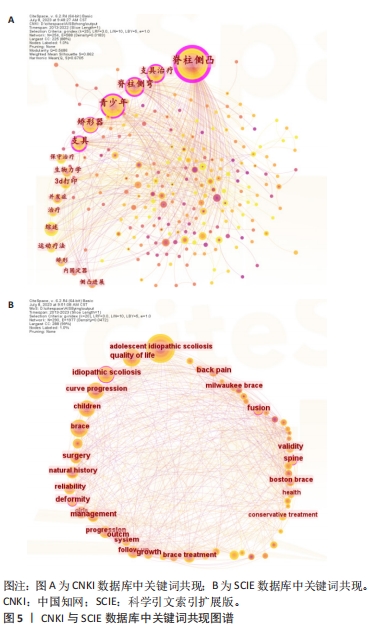
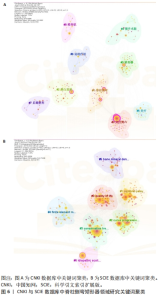
2.2.2 关键词聚类分析 通过关键词的聚类分析,能够挖掘到脊柱侧弯矫形器领域中的热点问题[27]。将数据导入Citespace中进行关键词聚类分析,如图6所示。在CNKI数据库中得到#0脊柱侧凸、#1脊柱侧弯、#2侧凸进展、#3矫形器、#4围手术期等聚类标签。从中可以看出,国内研究的重点方向为侧凸进展、围手术期等方面。在SCIE数据库中得到#0 quality of life (生活质量)、#1 cerebral palsy (脑瘫)、#2 curve progression(侧凸进展)、#3 conservative treatment(保守治疗)、#4 finite element(有限元)、#5 bone mineral density (骨密度)等聚类标签。国内外研究的侧重点略有不同,国外研究中包含脑瘫这一聚类,说明国外支具治疗与神经学有较多的联系,这与国外基础领域分布有一定的重合。围术期体现出支具治疗重要的一个方向是与手术治疗相配合进行综合治疗。"
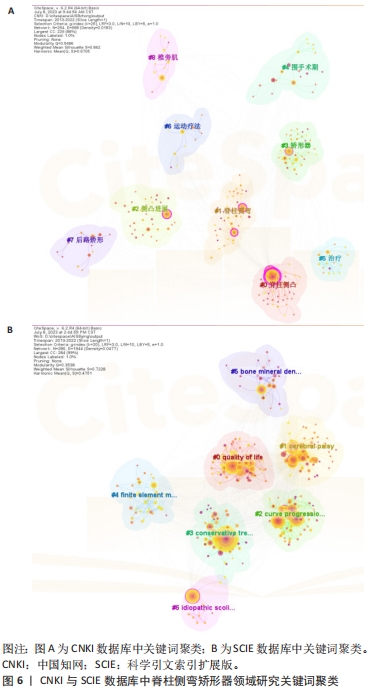
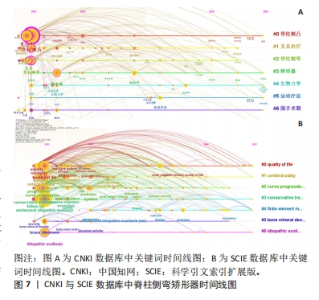
2.2.3 关键词时间线分析 通过探索聚类关键词在时间维度上的分布特征,可以把握关键词的整体动态变化过程,发现关键词的演进过程,关键词时间线图谱如图7所示。在CNKI数据库中,2013-2015年的关键词主要为青少年、侧凸进展、生物力学等,表明该时间段内致力于青少年脊柱侧弯矫形器的保守治疗。2015-2022年出现关键词为3D打印、个性化、运动疗法等,表明研究注重于脊柱侧弯矫形器个性化设计制作的新方法。在SCIE数据库中,2013-2015年的主要研究问题为侧凸进展、特发性、青少年特发性脊柱侧弯等。研究的主要主题为青少年特发性脊柱侧弯。2015-2022年中,CAD/CAM、生活质量、模拟等相关关键词出现频次较高,体现出矫形器设计制作与机械领域相结合。"
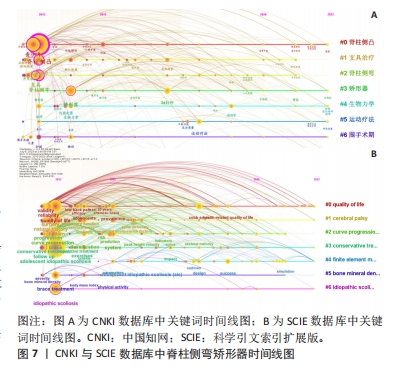
| [1] 刘小梅,周勇,王艳洋,等.3D打印技术结合计算机辅助设计在脊柱侧凸矫形器制作中的应用研究[J].医疗卫生装备,2023,44(5):74-80. [2] 盛文倩.个性化脊柱侧凸的有限元建模和分析[D].太原:太原理工大学,2021. [3] 周艳平,魏朝霞,徐伟,等.2019—2023年武汉市华中科技大学社区中小学生脊柱侧凸现状分析[J].职业卫生与病伤,2023,38(3):163-167. [4] WEINSTEIN SL, DOLAN LA, WRIGHT JG, et al. Effects of bracing in adolescents with idiopathic scoliosis. N Engl J Med. 2013;369(16):1512-1521. [5] NEGRINI S, DONZELLI S, AULISA AG, et al. 2016 SOSORT guidelines: orthopaedic and rehabilitation treatment of idiopathic scoliosis during growth. Scoliosis Spinal Disord. 2018;13:3. [6] 杜松,张岑炜,王霜,等.基于CiteSpace流行性乙型脑炎的中医药研究可视化分析[J].中国中医基础医学杂志,2022,28(7):1114-1119. [7] 陈定芳,吴月峰,李海英,等.基于CiteSpace文献计量法的中西医治疗痉挛型脑瘫文献可视化图谱分析[J].中草药,2021,52(14):4318-4326. [8] 陈科奕,王定宣,赵四可,等.加压训练在康复领域的研究热点及10年文献资料的可视化分析[J].中国组织工程研究,2022,26(15):2406-2411. [9] 邱东阳,阳富强,段在鹏.基于CNKI数据库的安全氛围研究文献计量分析[J].中国安全科学学报,2020,30(7):27-34. [10] 尹硕鑫,张涛,王舒萍,等.胃癌干细胞研究的文献计量学和可视化分析[J].中国组织工程研究,2023,27(6):941-947. [11] 曹树金,吴育冰,韦景竹,等.知识图谱研究的脉络、流派与趋势——基于SSCI与CSSCI期刊论文的计量与可视化[J].中国图书馆学报, 2015,41(5):16-34. [12] 梁晓颖.基于知识图谱的我国体育教学目标学术梳理研究[D].长春:东北师范大学,2019. [13] 帅秋萍,陈洁瑾.“四史”教育融入思政教育教学回顾与展望——基于CiteSpace知识图谱分析[J].淮北职业技术学院学报,2022,21(2):22-26. [14] 姬毅.政策视角下我国校园足球研究的热点、演进和趋势[D].西安:西安体育学院,2022. [15] 张晶晶.基于知识图谱的我国排球教学研究的可视化分析[D].济南:山东师范大学,2022. [16] 苏超怡.基于知识图谱的我国核心期刊与硕博论文乒乓球教学现状及热点研究[D].广州:华南理工大学,2021. [17] 黄忍,王星,李志军,等.青少年特发性脊柱侧弯的诊治进展[J].中国临床解剖学杂志,2016,34(4):472-475. [18] 杨宁,徐盼.运动干预青少年脊柱侧弯Cobb角的变化[J].中国组织工程研究,2013,17(22):4161-4168. [19] 赵菁,虞锡丹,徐纯鑫,等.青少年特发性脊柱侧凸的国内外治疗现状[J].南通大学学报(医学版),2018,38(3):203-205. [20] 张玉芳,关天民,郭侨阁,等.基于3D打印技术的个性化脊柱侧弯矫形支具数字化设计[J].中国组织工程研究,2019,23(36):5824-5829. [21] 张爱平,刘羲,刘志峰,等.基于3D打印的定制脊柱侧弯矫形器设计制造与舒适度评价[J].北京工业大学学报,2017,43(4):518-525. [22] HRESKO MT. Clinical practice. Idiopathic scoliosis in adolescents. N Engl J Med. 2013;368(9):834-841. [23] ALTAF F, GIBSON A, DANNAWI Z, et al. Adolescent idiopathic scoliosis. BMJ. 2013;346:f2508. [24] MONTICONE M, AMBROSINI E, CAZZANIGA D, et al. Active self-correction and task-oriented exercises reduce spinal deformity and improve quality of life in subjects with mild adolescent idiopathic scoliosis. Results of a randomised controlled trial. Eur Spine J. 2014;23(6):1204-1214. [25] SAMDANI AF, AMES RJ, KIMBALL JS, et al. Anterior vertebral body tethering for idiopathic scoliosis: two-year results. Spine (Phila Pa 1976). 2014;39(20):1688-1693. [26] 常悦.基于知识图谱的我国体育教学评价研究的可视化分析[D].郑州:河南大学,2022. [27] 葛昊,刘贤旺,黄艺伟,等.后交叉韧带重建的国际研究趋势与热点分析[J].中国组织工程研究,2024,28(18):2947-2952. [28] 胡丽杰.脊柱侧凸特定运动—BSPTS疗法对轻度青少年特发性脊柱侧凸的疗效观察[D].天津:天津体育学院,2022. [29] 任文博,廖远朋,钟睿,等.2012~2021年青少年特发性脊柱侧凸研究内容与热点的可视化分析[J].中国脊柱脊髓杂志,2022,32(2):169-173. [30] 张宸洁,董静梅.青少年特发性脊柱侧凸的神经—肌肉系统调控机制研究进展[J].中国学校卫生,2023,44(8):1266-1271. [31] GIAMPIETRO PF, HADLEY-MILLER N, RAGGIO CL. Overview of Gene Special Issue “Genetic Conditions Affecting the Skeleton: Congenital, Idiopathic Scoliosis and Arthrogryposis”. Genes (Basel). 2022;13(7):1194. [32] PENG Y, WANG SR, QIU GX, et al. Research progress on the etiology and pathogenesis of adolescent idiopathic scoliosis. Chin Med J (Engl). 2020; 133(4):483-493. [33] LIANG ZT, GUO CF, LI J, et al. The role of endocrine hormones in the pathogenesis of adolescent idiopathic scoliosis. FASEB J. 2021;35(9):e21839. [34] KAMAL Z, ROUHI G, ARJMAND N, et al. A stability-based model of a growing spine with adolescent idiopathic scoliosis: A combination of musculoskeletal and finite element approaches. Med Eng Phys. 2019;64:46-55. [35] WATANABE K, MICHIKAWA T, YONEZAWA I, et al. Physical Activities and Lifestyle Factors Related to Adolescent Idiopathic Scoliosis. J Bone Joint Surg Am. 2017;99(4):284-294. [36] 张臻,张迦琅,冯铭哲,等.支具治疗青少年特发性脊柱侧凸的研究进展[J].骨科,2023,14(1):87-91. [37] 侯召猛,苏少亭,陈龙豪,等.青少年特发性脊柱侧凸研究热点及趋势的可视化分析[J].中国组织工程研究,2024,28(21):3424-3430. [38] 詹佳楠,杨洋,黄文华.3D打印技术在康复支具制作的应用研究[J].中国医学物理学杂志,2022,39(10):1310-1312. [39] 于文强,侯俞彤,黄承兰,等.3D打印脊柱侧凸矫形器的矫正效果[J].中国康复理论与实践,2023,29(4):390-395. [40] ZHANG Y, YANG Y, DANG X, et al. Factors relating to curve progression in female patients with adolescent idiopathic scoliosis treated with a brace. Eur Spine J. 2015;24(2):244-248. [41] CHEUNG JPY, CHEUNG PWH. Supine flexibility predicts curve progression for patients with adolescent idiopathic scoliosis undergoing underarm bracing. Bone Joint J. 2020;102-B(2):254-260. [42] FONG DY, CHEUNG KM, WONG YW, et al. An alternative to a randomised control design for assessing the efficacy and effectiveness of bracing in adolescent idiopathic scoliosis. Bone Joint J. 2015;97-B(7):973-981. [43] 伍伟飞,朱泽章,邱勇,等.青少年特发性脊柱侧凸严重程度和弯型与SRS-22问卷评分的相关性分析[J].中国脊柱脊髓杂志,2012,22(10): 909-913. |
| [1] | Xu Canli, He Wenxing, Wang Lei, Wu Fangting, Wang Jiahui, Duan Xuelin, Zhao Tiejian, Zhao Bin, Zheng Yang. Bibliometric analysis of researches on liver organoids [J]. Chinese Journal of Tissue Engineering Research, 2024, 28(7): 1099-1104. |
| [2] | Sun Yukang, Song Lijuan, Wen Chunli, Ding Zhibin, Tian Hao, Ma Dong, Ma Cungen, Zhai Xiaoyan. Visualization analysis of stem cell therapy for myocardial infarction based on Web of Science in recent ten years [J]. Chinese Journal of Tissue Engineering Research, 2024, 28(7): 1143-1148. |
| [3] | Xu Yi, Deng Yubin. Exoskeleton-assisted walking rehabilitation for spinal cord injury: CiteSpace analysis of research hotspots [J]. Chinese Journal of Tissue Engineering Research, 2024, 28(33): 5403-5412. |
| [4] | Yan Jie, Zhou Jing, Zhao Jingpu, Zhang Qingfang, Zhou Mingchao, Wang Yulong. Visual analysis of high-definition transcranial direct current stimulation research [J]. Chinese Journal of Tissue Engineering Research, 2024, 28(32): 5110-5115. |
| [5] | Tao Guangyi, Wang Linzi, Yang Bin, Huang Junqing. Research hotspots of artificial intelligence in the field of spinal deformity: visual analysis [J]. Chinese Journal of Tissue Engineering Research, 2024, 28(30): 4915-4920. |
| [6] | Zhang Zhilong, Yang Shengping, Chen Tianxin, Zhu Yuqi. Research hotspots and trends in the field of articular cartilage repair: a visualization analysis [J]. Chinese Journal of Tissue Engineering Research, 2024, 28(27): 4306-4311. |
| [7] | Duan Yanzhe, Hua Jianlin, Ding Zhibin, Jiang Nan, Song Lijuan, Yan Yuqing, Ma Cungen. Visual analysis of the effect of apoptosis on ischemic stroke [J]. Chinese Journal of Tissue Engineering Research, 2024, 28(26): 4145-4150. |
| [8] | Xia Tianqing, Rong Mengwei, Dan Cunyan, Yang Ting, Ding Zhibin, Song Lijuan, Ma Cungen. Frontier hot trends in ischemic stroke and vascular regeneration based on bibliometric analysis [J]. Chinese Journal of Tissue Engineering Research, 2024, 28(23): 3692-3698. |
| [9] | Hou Zhaomeng, Su Shaoting, Chen Longhao, Wei Guikang, Zhou Honghai. Visualization analysis of research hotspots and trends in adolescent idiopathic scoliosis [J]. Chinese Journal of Tissue Engineering Research, 2024, 28(21): 3424-3430. |
| [10] | Ye Xiaolong, Ma Yuan. Visualization analysis of magnetically controlled growing rod in treatment of spinal deformities [J]. Chinese Journal of Tissue Engineering Research, 2024, 28(15): 2323-2329. |
| [11] | Hong Jing, Lu Congfei, Huang Chenbin, Jiang Qian, Liu Jingxiong. Visualization analysis of hot spots and trends in material biomechanics [J]. Chinese Journal of Tissue Engineering Research, 2024, 28(15): 2358-2363. |
| [12] | Gong Xuan, Wang Qian, Lin Junbin. Visual analysis of extracorporeal shock wave therapy for pain [J]. Chinese Journal of Tissue Engineering Research, 2024, 28(11): 1749-1755. |
| [13] | Xu Kangli, An Lanhua, Zhang Jinsheng, Du Xiaoyan, Yin Lele, Zhang Xixian. Research hotspots and frontiers of functional magnetic resonance imaging in treatment of ischemic stroke by traditional Chinese medicine [J]. Chinese Journal of Tissue Engineering Research, 2024, 28(11): 1789-1796. |
| [14] | Chen Guanting, Zhang Linqi, Li Qingru. Research hot spots and trends of exosomes in theranostic application for chronic kidney disease [J]. Chinese Journal of Tissue Engineering Research, 2024, 28(1): 86-92. |
| [15] | Yin Shuoxin, Zhang Tao, Wang Shuping, Lu Xin, Huang Xuping, Yin Mengying, Yang Yuwei, Yuan Bingmao, Mao Zhihua, Chen Yuanneng. Bibliometric and visualized analysis of researches on gastric cancer stem cells [J]. Chinese Journal of Tissue Engineering Research, 2023, 27(6): 941-947. |
| Viewed | ||||||
|
Full text |
|
|||||
|
Abstract |
|
|||||
